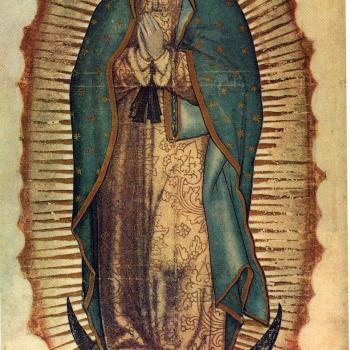What’s good for the goose dot dot dot
Robert Barron, whose fame came with his evangelistic presence in Word on Fire Catholic Ministries (I prefer to keep the printed page as far as possible from flames) and is now the auxiliary bishop of Los Angeles, wrote recently about the way to evangelize nones (those Americans who tell pollsters they have no religion). Barron argues that one way to reach nones is through beauty, the way that Charles Ryder from Brideshead Revisited, came to faith through “an aesthetic education.” Ryder goes from skeptic to believer through the path of beauty and then goes on to accept the truth of Roman Catholicism.
Barron thinks that Rome really has the goods when it comes to aesthetics. He quotes Ewert Cousins who says that Roman Catholicism’s genius is never to have “thrown anything out.” The church has a “grandma’s attic” quality that goes from Chartres Cathedral, The Sainte-Chapelle, the Sistine Chapel to the “haunting icons of the East, Dante, Mozart, and the image of our Lady of Guadalupe.” Rome resisted Protestantism’s “iconoclastic temptation” and kept everything. Supposedly, then, a believer can find a niche in Rome’s clutter on which to hang his or her faith, even be surrounded by lots of comforts and aids for the journey.
The problem is, though, that sometimes Rome does exclude and sometimes it holds on to things it should have put out with the trash. Barron later in the essay notes that William of Occam’s univocal understanding of God (compared to Aquinas’ analogical view) was an idea that Rome rejected or should have, partly because Occam supposedly fed the Protestant Reformer’s ideas about God’s relationship to the world. For Barron, Protestants saw glory as a zero-sum game. “If God is to get all of the glory, the world has to be emptied of glory; if grace is to be fully honored, nature has to be denigrated; if salvation is all God’s work, cooperation with grace has to be denied.” Aside from the Reformers’ doctrine of God, a big difference between Rome and Protestants is that the latter actually see choices that have to be made while the former seems to want to avoid making those choices. The irony, of course, is that Roman Catholic theologians did reject Occam and the magisterium at Trent threw out Protestantism. Those choices indicate that the “grandma’s attic” quality to Rome has limits. In fact, prior to Vatican II the church had a far easier time discerning when to call the waste disposal operators. Beauty was no match or mortal sins or heterodox teaching.
Yet, at times the clutter of Rome’s attic includes those pieces like the Feast of San Gennaro, a twelve-day food and musical extravaganza in New York City’s Little Italy. Abel Ferrara returned to his old neighborhood to make a documentary about the festival. Oh, by the way, the movie was short on devotion and long on vendors preparing to make money and have fun during the week-and-a-half of celebrations. According to a story in the Jesuit magazine, America:
Festival organizers see their role as informing and reminding guests of the original meaning of the celebration. Whenever he gets the chance, Bill Russo, director of activities for the parish, tries to tell people about the story of San Gennaro. Gennaro was a third-century bishop of Benevento during the period of Christian persecution under Emperor Diocletian. After visiting imprisoned clergy, Bishop Gennaro was also imprisoned, tortured and beheaded. Vials of the saint’s blood are still preserved in Naples. Each year on Sept. 19, San Gennaro’s feast day, the relics are shown to the public, and they often turn from solid powder to liquid (called the Miracle of Liquefaction). Neapolitans have long believed that this is a sign of blessing for the upcoming year.
But as Ferrara’s documentary indicates, very few of the people attending the Feast have devotion on their minds. More like meatballs:
At first glance, it seems like the religious and cultural elements of the festival fight for attention. Few festival-goers wandered into the Mass (most were there long before Mass began), and many seemed confused when asked to vacate the street for the Tuesday night procession. New York crowds are drawn to the feast’s Italian-American performances, a dedicated opera night and two food-eating competitions.
Ferrara Bakery and Cafe, a long-standing neighborhood restaurant, provided meatballs for the second-annual meatball eating competition. The contest began in 2016 as a tribute to the late John “Cha-Cha” Ciarcia, restaurateur and “Unofficial Mayor of Little Italy.” . . .
Both the Mass and the meatball eating competition were about connecting to the past. One celebrated a distant fourth-century martyr, while the other celebrated the charismatic “mayor” who is still a part of Little Italy’s living memory. For the early Italian immigrants, culture and faith were interwoven. Perhaps today’s descendants have less of an explicit connection to their faith, but it still lives in cultural traditions like the Feast of San Gennaro.
In which case, Rome may have more stuff than Protestantism, more ties between culture and faith, beauty (high and tacky) and devotion, but Roman Catholicism is no more thick than evangelicalism. Rome has had as much trouble holding on to its adherents as evangelicals have discerning the virtues of presidential candidates. In fact, one could argue that by not being strict about what stays in the attic (the way Rome was in the sixteenth century), Roman Catholics may not have the kind of direction to point them in ways that remain true to the church.
Thickness may matter less than that age-old attention grabber: what does the Lord require?












